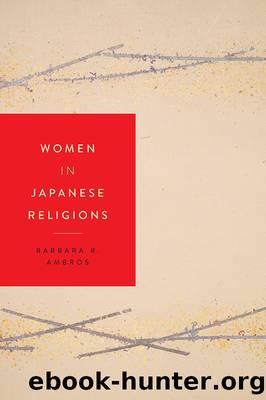Women in Japanese Religions by Barbara R. Ambros

Author:Barbara R. Ambros [Ambros, Barbara R.]
Language: eng
Format: epub
ISBN: 9781479884063
Barnesnoble:
Publisher: New York University Press
Published: 2015-05-29T00:00:00+00:00
Masculinizing the Shinto Priesthood and Shinto Weddings
Like the Buddhist clergy, the Shinto priesthood was also redefined. During the Edo period, the Shinto priesthood had been very religiously diverse, localized, and largely hereditary. It often overlapped with Buddhist clerics and mountain ascetics and was only partially controlled by sacerdotal Shinto lineages. During the early Meiji period, the Shinto priesthood came under the control of the Department of Divinity, which was later renamed the Ministry of Divinity. In 1871, the priesthood lost their right to hereditary succession and instead became state-appointed bureaucrats certified through national examinations. Shinto rites conducted by the emperor, which were revived under the auspices of the Department of Divinity, were redefined as public state rites rather than private observances. In this process, the Shinto priesthood was largely masculinized and the ceremonial roles that women held at the imperial court were also tightly controlled.25
The process of masculinization is apparent at the Ise Shrines. In the Edo period, the position of the master celebrant (saishu) had been hereditarily held by women of the Fujinami clan. The master celebrantâs most important role was that of leading the divine procession from the old to the new shrine buildings during periodic reconstructions of the precinct as a representative of the imperial house. After the Meiji Restoration, a male member of the imperial family took over this role. The position remained in male hands until the end of World War II.26
Women were also prohibited from serving as priests at village Shinto shrines. In 1874 the question arose whether women could, in the absence of suitable male candidates, hold the position of shrine priest and, like Buddhist nuns, participate in the Promulgation Campaign of the Great Teaching (1870â1884), which was meant to indoctrinate the populace with the new imperial ideology. The authorities decided that women could not hold the office of a shrine priest because women could not hold public offices.27 In general, women who had functioned as shamanic mediums and dancers at shrines lost their positions and were unable to regain their certifications.28 In the 1910s, Miyamoto Shigetane (1881â1959), the priest at Nisho Yamada Shrine in Yamaguchi Prefecture and founder of Keishin fujinkai, a national Shinto married womenâs association, stressed the historical precedent for womenâs priestly roles. Although he called in the associationâs journal, JoshidÅ (The Way of Women), for the revival of priestly positions for women, female shrine priests did not reappear until after 1945.29
Moreover, in 1873 independent shamans such as catalpa-bow shamans and blind shamans (ichiko) were officially prohibited from serving as spirit mediums, conducting exorcisms, or performing divination. These injunctions were soon followed by prohibitions against healing rituals.30 Until 1945, shamans, spirit mediums, and folk healersâmany of whom were womenâfaced continued harassment and suppression by the authorities. The most common charges against them were licentiousness, extortion, and physically harming their clients with folk remedies. As the Meiji regime promoted the adoption of Western medicine and psychology in order to build a strong nation, folk remedies were seen as detrimental to the health of the nation.
Download
This site does not store any files on its server. We only index and link to content provided by other sites. Please contact the content providers to delete copyright contents if any and email us, we'll remove relevant links or contents immediately.
Cecilia; Or, Memoirs of an Heiress — Volume 1 by Fanny Burney(32434)
Cecilia; Or, Memoirs of an Heiress — Volume 2 by Fanny Burney(31871)
Cecilia; Or, Memoirs of an Heiress — Volume 3 by Fanny Burney(31854)
The Great Music City by Andrea Baker(31349)
We're Going to Need More Wine by Gabrielle Union(18967)
All the Missing Girls by Megan Miranda(15570)
Pimp by Iceberg Slim(14393)
Bombshells: Glamour Girls of a Lifetime by Sullivan Steve(13972)
Talking to Strangers by Malcolm Gladwell(13222)
Norse Mythology by Gaiman Neil(13204)
Fifty Shades Freed by E L James(13157)
For the Love of Europe by Rick Steves(12983)
Mindhunter: Inside the FBI's Elite Serial Crime Unit by John E. Douglas & Mark Olshaker(9200)
Crazy Rich Asians by Kevin Kwan(9167)
The Lost Art of Listening by Michael P. Nichols(7406)
Enlightenment Now: The Case for Reason, Science, Humanism, and Progress by Steven Pinker(7231)
The Four Agreements by Don Miguel Ruiz(6630)
Bad Blood by John Carreyrou(6552)
Weapons of Math Destruction by Cathy O'Neil(6143)
